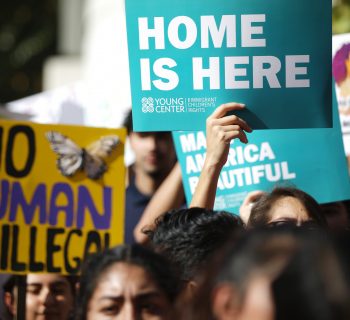By David Kampf ~ Photo by Daily Gazette ~ November 2, 2018
Xenophobic. Racist. Anti-American. An inhumane and expensive boondoggle. Critics of Donald Trump’s proposed wall along the U.S.-Mexico border see it as a disaster in the making, and some of these Trump administration opponents seem willing to reject paying for a wall at all costs. “It happens to be like a manhood issue for the president, building a wall, and I’m not interested in that,” House Minority Leader Nancy Pelosi said in mid-October at a Harvard Institute of Politics discussion, after she told one attendee that she would be willing to trade “nothing” in exchange for the wall.
But, why? When it comes to immigration, Democrats should take heed of the bigger picture and bend rather than break on the smaller issues—like the wall. If Democrats are interested in a more humane immigration policy as a whole, they should push for a higher refugee ceiling and a simultaneous enhancement of border security to help more people and those who are most in need. A more humane immigration agenda would certainly also include a stop to the forcible separation of children and parents (ended for now, but reportedly being reconsidered by the Trump administration) and a fix for Deferred Action for Childhood Arrivals to make sure that immigrants who have barely known their country of origin can’t be deported. And such a plan would also ensure that no immigrant is turned away on the basis of gender, religion, race or ethnicity. These concerns are much larger than any kind of human rights concerns posed by the wall, and Democrats should trade the wall for solutions on some of them instead.
First, ignoring Americans’ widespread concerns over immigration and border enforcement is politically unsustainable. Rising nationalism around the world will not soon disappear, and the number of global migrants is likely to rise—not fall—in the future. In the United States, illegal immigration was the highest-rated concern among Republican voters in polling released on October 15. In Europe, voters in 21 of 28 countries surveyed cited immigration as the top issue facing the continent, despite steadily decreasing migrant arrivals. If real steps aren’t taken to manage the numbers of migrants, then the public backlash will increase and anti-immigrant platforms and candidates will continue to win elections. Eventually, the politicians elected on these sentiments will obtain enough power to severely cut immigration and make it difficult to reverse course, as we’ve seen across Europe in recent years with the popularity of anti-immigrant candidates in Germany, Italy and Hungary. In the end, fewer migrants will be allowed to legally enter the United States, and American economic interests and global stability—not to mention the human lives caught in the political crossfire—will suffer.
The wall is Trump’s defining immigration obsession, the rallying cry at his campaign events and the symbol of his naked appeals to nativism and racism. It also happens to pose the least humanitarian concern out of his whole immigration agenda. Democrats should let him have it—and watch as the toxic anti-immigrant politics that Trump has fueled begin to fade.
After the election, Democrats will have plenty of opportunity, with a threatened government shutdown in December and the promise of a post-midterm fight over the border wall, to trade funding for the wall for other immigration wins, such as increasing the number of refugees the United States admits, curbing harsh immigration enforcement, fixing DACA and boosting aid to the troubled Central American countries whose citizens are fleeing north to escape violence and poverty.
Raising the refugee cap is essential for a smarter immigration policy: In the past fiscal year, the United States admitted its lowest number of refugees in 40 years and has set a historically low cap for next year at a time when there has never been more refugees in the world. (More than 68 million people, larger than the populations of France or the United Kingdom, are currently displaced globally.) Washington is shirking its global responsibility, placing the burden on the shoulders of poorer countries, like Lebanon, Jordan and Uganda, that are ill-equipped to handle large numbers of displaced people. Politically, Democrats should also emphasize the fact that all refugees are heavily vetted before entering the United States and that there is no evidence that refugees who have been admitted heighten the risk of terrorist acts—homegrown terrorists pose a much greater threat.
Democrats should also focus more of their attention on a permanent solution for the so-called Dreamers, or DACA recipients, and curbing overzealous immigration enforcement by Immigration and Customs Enforcement officials and going back to treating immigration violations as civil offenses rather than criminal ones. The hundreds of thousands of undocumented immigrants who were brought to the country as children should be offered a path to citizenship.
Any long-term immigration deal between the parties should also provide effective security assistance to reduce violence in other countries, because without addressing what migration experts call “push” factors—a lack of economic opportunity or gang violence in a migrant’s country of origin, for instance—border and interior immigration enforcement can go only so far in deterring migration. Under Trump, U.S. assistance to Central America has been cut—and he is threatening to make further cuts—but any immigration policy that seeks to quell the influx of migrants coming from those countries would be incomplete without restoring that funding, or, even better, increasing it.
Democrats may not be able to get all of these things, but stonewalling on Trump’s wall is a waste of their energy when it comes to combating the far less symbolic immigration crises facing the country.
It is in America’s national interest to design a more forward-looking migration policy. In fact, the United States will need more (not less) migration to address its looming demographic challenges. Fertility rates are at record lows. The nation’s ratio of retirement-age seniors to working-age adults is expected to rise, from 25 seniors per every 100 working-age adults in 2017 to 35 per 100 in 2030—and it will keep rising. Barring major reductions to Social Security and Medicare, there will not be enough workers to financially support the elderly in the future without increases in immigration.
And even if it didn’t ultimately serve our economic and social interests, neither party would be able to stop migration to the United States. While the United States and other wealthy countries are aging, and less able to fill available jobs, many developing countries are young with rapidly growing populations, most of whose members need jobs. This will increase the pressure to migrate from poor to rich countries—yet one more reason for Washington to develop a sustainable migration policy.
That inevitability sets us up for a political standoff. Allowing more open borders is politically infeasible, but trying to block immigration with no attention to the causes that drive it is unrealistic. A more sustainable, long-term solution for Democrats would be to strengthen border enforcement while treating the root causes of migration and maintaining a commitment to a welcoming immigration and asylum system overall. President Barack Obama adopted a tough enforcement policy as well, but he did so relatively quietly—it’s safe to assume that Trump will not be quiet about building a wall. This should be enough noise to ease the fears of immigration, providing cover for durable humanitarian gains.
The price of building a wall is well worth paying if it facilitates a new and sustainable U.S. immigration policy.







